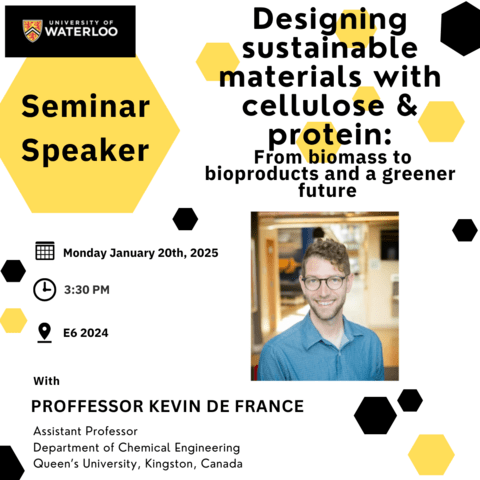Welcome to Chemical Engineering at the University of Waterloo
As part of Canada's largest engineering school and most innovative university, the Department of Chemical Engineering at the University of Waterloo is home to approximately 1,000 students, faculty and staff, and has thousands of alumni worldwide.
Our Department consistently ranks among the top two universities in Canada and the number one university in Ontario in Chemical Engineering according to the Shanghai Academic Ranking of World Universities.
In addition to offering undergraduate and graduate programs in chemical engineering, the Department provides academic expertise and support to Waterloo's collaborative nanotechnology and biomedical engineering programs.
The department's collaborative research culture, engaging teaching practices and state-of-the-art facilities create a vibrant learning environment where students are empowered to solve the problems our world faces.
Learn about Professor Michael Pope's research in the field of electrochemical energy systems and about the newly established Ontario Battery and Electrochemistry Research Centre.
Are you wondering what Chemical Engineering is? Check out our new animation!
Chemical Engineering Lab Tour
Join us for a tour of the Chemical Engineering undergraduate labs in the Douglas Wright Engineering Building at the University of Waterloo.
Find out more by exploring the programs, research and news stories on this site.
News
Engineering bacterial sex to remove plastic waste in water systems
Researchers at the University of Waterloo are taking a novel approach to tackle the critical issue of microplastic pollution in water systems. The research team is engineering bacteria that already exist in wastewater to break down Polyethylene terephthalate(PET).
Plastic waste in water systems is an urgent environmental concern. PET plastics degrade into microplastics that adversely impact the ecosystems of our lakes, rivers, and oceans.
Professor Marc Aucoin from the Department of Chemical Engineering and Professor Brian Ingalls from the Department of Applied Mathematics with PhD student Aaron Yip are developing a technique that enables wastewater bacteria to break the links between plastic molecules so PETs can be degraded.
Chemical Engineering professors named as Highly Cited Researchers™
Professors Aiping Yu and Michael Fowler have been named on the Highly Cited Researchers™ list from Clarivate. Researchers on that list have publications that rank in the top one percent of citations globally and are deemed influential in their respective fields.
Yu’s research expertise is in utilizing graphene for energy storage in Zinc-ion and Na-ion batteries to increase their energy and power density using 2D materials. As Director of the Applied Carbon Nanotechnology Laboratory, she is also focused on lithium battery recycling. Yu is also researching carbon dioxide conversion, using electrochemical cells to turn CO2 into small-chain chemicals like methane.
Turning food waste into eco-friendly plastics with the power of bacteria
Researchers at the University of Waterloo can now make eco-friendly plastics using bacteria that feed on food scraps from your table. Unlike animals that store fat when they consume excess food, these bacteria store a biopolymer. Biopolymers are natural polymers produced by the cells of living organisms that are fully biodegradable. The biopolymer can be used in multiple applications, including single-use plastics.
Utilizing food waste is beneficial to the environment as it typically generates methane and carbon dioxide when decomposing in landfills, contributing to greenhouse gases.
Plastics produced using this new method have many potential applications. For example, in food packaging as a plastic film to cover meat.
Events
Graduate Seminar| Designing sustainable materials with cellulose & protein: from biomass to bioproducts and a greener future, by Professor Kevin de France
The Chemical Engineering Department is hosting a graduate seminar on Designing sustainable materials with cellulose & protein: from biomass to bioproducts and a greener future.
Graduate Seminar| Mechanochemistry and aging-based methods as novel tools to transform biopolymers into high value materials, by Professor Audrey Moores
The Chemical Engineering Department is hosting a graduate seminar on Mechanochemistry and aging-based methods as novel tools to transform biopolymers into high value materials.
Chemical Engineering Graduate Recruitment Fair
See our faculties, meet faculty and current students! Join us for refreshments!















